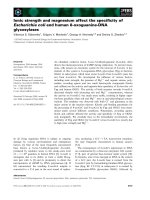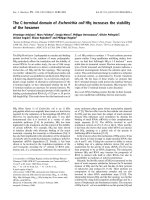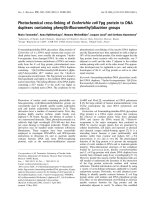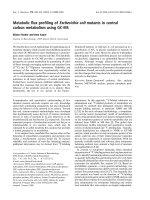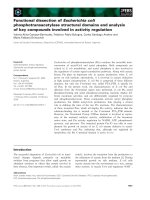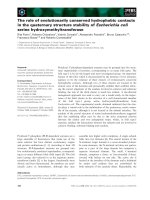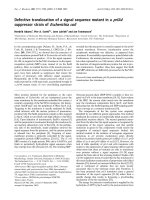Molecular detection and subtyping of new delhi metallobetalactamases (NDM-1) in clinical isolates of escherichia coli and klebsiella pneumoniae in a Tertiary Care Hospital, South India
Bạn đang xem bản rút gọn của tài liệu. Xem và tải ngay bản đầy đủ của tài liệu tại đây (443.7 KB, 7 trang )
Int.J.Curr.Microbiol.App.Sci (2017) 6(5): 2264-2270
International Journal of Current Microbiology and Applied Sciences
ISSN: 2319-7706 Volume 6 Number 5 (2017) pp. 2264-2270
Journal homepage:
Original Research Article
/>
Molecular Detection and Subtyping of New Delhi Metallobetalactamases
(NDM-1) in Clinical Isolates of Escherichia coli and
Klebsiella pneumoniae in a Tertiary Care Hospital, South India
M. Uma Maheswari* and Appalaraju
Department of Microbiology, PSGIMS & R, Coimbatore, India
*Corresponding author:
ABSTRACT
Keywords
NDM-1Newdelhi
metallobetalactamases.
Article Info
Accepted:
25 April 2017
Available Online:
10 May 2017
Enterobacteriaceae are inhabitants of human, animal gastrointestinal tract and various
other environmental sites. Escherichia coli and Klebsiella pneumoniae initially responded
to betalactam antibiotics but there was an increase in resistance to betalactam antibiotics
due to beta lactamase produced by them. Resistance to carbapenems has now become
more prevalent due to production of carbapenemases. NDM-1 is a novel metallo
betalactamase that is capable of hydrolysing all beta lactam antibiotics except Aztreonam.
It was aimed for Molecular detection and subtyping of NDM-1 in Escherichia coli and
Klebsiella pneumoniae. Hundred carbapenem resistant isolates (42 isolates of Escherichia
coli and 58 isolates of Klebsiella pneumoniae) were selected randomly for Molecular
detection and sequencing of subtypes. A total of 82% strains were found to be NDM-1
positive yielding 475bp amplicon by molecular methods. Nine samples were sequenced for
subtypes, of which five were NDM-1, two were NDM-4, and remaining two were NDM-3,
and NDM-5.Sequencing and finding out of the subtypes may help to select new drug
targets and design novel antibiotics.
Introduction
Enterobacteriaceae are inhabitants of wide
variety of niches, including the human,
animal gastrointestinal tract and various other
environmental
sites.
The
family
Enterobacteriaceae includes a large number
and diversity of genera.
During the past decade, there has been an
emergence
of
carbapenems-resistant
Enterobacteriaceae
that
produce
carbapenamases, enzymes that efficiently
hydrolyze carbapenems, as well as most βlactam drugs (Queenan et al., 2007). New
Delhi
Metallo-beta-lactamases-1 (NDM-1)
are one such carbapenamase that makes
bacteria resistant to a broad range of betalactam antibiotics. These include the
antibiotics of the carbapenems family, which
are a mainstay for the treatment of antibioticresistant bacterial infections. Bacteria that
produce carbapenamases are often referred to
in the news media as "superbugs" because
infections caused by them are difficult to
treat.
Such bacteria are usually susceptible only
to polymyxins and tigecycline. NDM-1 was
first
detected
in
a Klebsiella
pneumoniae isolate from a Swedish patient
of Indian origin in 2008. It was later detected
2264
Int.J.Curr.Microbiol.App.Sci (2017) 6(5): 2264-2270
in bacteria in India, Pakistan, the United
Kingdom, the United States, Canada, and
Japan (Kumarasamy et al., 2010).
Materials and Methods
Study population
After Ethical clearance from the institution,
the study was conducted between April 2014
and August 2015 on various clinical samples.
Two thousand and forty two isolates of
Escherichia coli and thousand hundred and
ninety two isolates of Klebsiella pneumoniae,
were identified by IMViC tests. Of which
Five hundred and sixty isolates of Klebsiella
pneumoniae (47%) and hundred and forty
eight isolates of Escherichia coli (7%) were
resistant to carbapenems. Among them
hundred isolates were selected randomly for
the study (42 isolates of Escherichia coli and
58 isolates of Klebsiella pneumoniae)
Isolation
of
carbapenem
resistant
Escherichia coli and Klebsiella pneumoniae
The isolates were screened for the production
of Carbapenam resistance as per CLSI 2014,
using Ertapenem 10ug and Merapenam 10ug
disc. The zone diameter of inhibition less than
19-21mm for Ertapenem and less than 1621mm
for
Merapenam
indicates
Carbapenemase production. As per CLSI
2014 Ertapenem non susceptibility was the
most sensitive indicator of Carbapenem
resistance. Isolates were also tested by
automated identification system (VITEK 2)
for carbapenem resistance, based on Minimal
Inhibitory Concentration. Among them a total
of 100 isolates (42 isolates of Escherichia coli
and 58 isolates of Klebsiella pneumoniae)
were selected randomly for molecular study.
DNA extraction
The isolates were incubated overnight at 35ºC
in Luria broth. About 2-3 ml of inoculum was
centrifuged at 5000rpm for 10 minutes. After
centrifugation the supernatant was discarded
and the pellet was taken in a sterile Eppendorf
tube. The pellets were resuspended in distilled
water and kept in a water bath at 95ºC for 20
minutes. It was then cooled and centrifuged at
5000 rpm for 10 minutes. The supernatant
was the extracted DNA and is stored at -20ºC.
Polymerase chain reaction
The extracted DNA was mixed with forward,
reverse primers for NDM-1, master mix and
PCR water and amplified in step one AB
applied Bio system Real time PCR
machine.PCR cycle consists of the following
steps (Jeremiah et al., 2014). Initial
denaturation at 94°C for 3 min, Denaturation
at 94°C for 30 s Annealing at 60°C for 25
Extension at 72°C for 30 s, Final extension at
72°C for 3 min for 30 cycles. The amplified
products are stored at -20ºC. Gel
Electrophoresis was run. The images of the
gel were captured by Gel doc and viewed.
The presence of the NDM-1 gene was
confirmed by the formation of bands at
475bp.
Gene sequencing and blasting
The amplied products which were confirmed
for the presence of NDM-1 were sent for gene
sequencing to Eurofins Genomics Bangalore.
The sequenced genes were blasted using BIO
EDIT software and results were interpreted in
the NCBI (National centre for Biotechnology
Information) website.
Results and Discusion
Two thousand and forty two isolates of
Escherichia coli and thousand hundred and
ninety two isolates of Klebsiella pneumoniae,
were identified in various clinical samples
during the study period, of which Five
hundred and sixty isolates of Klebsiella
pneumoniae (47%) and hundred and forty
2265
Int.J.Curr.Microbiol.App.Sci (2017) 6(5): 2264-2270
eight isolates of Escherichia coli (7%) were
resistant to carbapenems. Among them Forty
two isolates of Escherichia coli and Fifty
eight isolates of Klebsiella pneumoniae were
selected for molecular study.
any type of infectious diseases and recovered
from any specimen received in the laboratory.
Escherichia coli and Klebsiella pneumoniae
cause sepsis, endotoxic shock, urinary tract
infections, meningitis in neonates and
pneumonia in immune compromised.
Polymerase chain reaction
Among the hundred isolates, eighty two
(82%) were found to be NDM-1 positive
(475bp) by PCR. Gel pattern of NDM-1 is
depicted (Fig 1). Thirty seven (88%) of
Escherichia coli and Forty five Klebsiella
pneumoniae (77%) were NDM-1 producers.
Subtypes of NDM-1
Nine samples of amplified DNA (25ul) were
sent randomly for sequencing at Euro fin
genomics India pvt Ltd in Bangalore. Among
them four were Escherichia coli and five were
Klebsiella pneumoniae. The results send by
the Eurofins Genomics were subjected to
gene blasting using the BIO EDIT software
and the sequence results were interpreted in
NCBI (National centre for Biotechnology and
Information) web site as shown in figures 2
and 3. On interpretation it was found that
Amplicon-1, Amplicon -2, Amplicon -4,
Amplicon -6 and 8 had amino acid sequences
of NDM-1 and Amplicon -3 was NDM-5 and
Amplicon -5 was NDM-3 and Amplicon -7
and Amplicon -9 were NDM-4. NDM-5
showed a point mutation variant differing
from NDM-1 having a Met to Leu (M-L)
substitution at 154 and Val to Leu (VL)substitution at 88. NDM-3 showed a point
mutation variant differing from NDM-1
having substitution of Asp to Asn (D-N) at
95.NDM-4 differs from NDM-1 by a single
amino acid substitution (M-L) at 154 (Met to
Leu) which is shown in table 1.
Gram negative bacteria belonging to the
family of Enterobacteriaceae are the most
frequently isolated organisms from clinical
specimens. They are incriminated in virtually
They are normally treated based on the
antibiotic sensitivity, site of infection and comorbidity conditions (Longo et al., 2011).
Escherichia coli and Klebsiella infections
initially responded to betalactam antibiotics,
but there was a dramatic increase in resistance
to beta lactam antibiotics due to
betalactamases produced by them. This
resistance was superseded by use of second
and third generation cephalosporins and
combination of betalactam antibiotics with
betalactamases inhibitors (Nosocomial burn
wound infections, 2004).
Further with the emergence of ESBLs and
Amp C resistance, carbapenems became the
drug of choice. There has been a rapid
increase in carbapenems resistance in
Enterobacteriaceae in the recent years. The
carbapenems resistance may be due to
carbapenamases production, Efflux pump and
Amp C enzyme production with membrane
impermeability. However, carbapenamases
(betalactamases) were found to be the
predominant mechanism of this resistance.
Among the newly emerged carbapenamases,
New Delhi Metallo betalactamases (NDM-1)
represents a war between the bugs and
drugs.NDM-1 producing organisms are called
super bugs (BorA et al., 2012).
NDM-1 was first reported in 2008 in
Klebsiella pneumoniae and Escherichia coli.
Both of them were recovered from a Swedish
patient of Indian origin who was previously
admitted in a hospital in New Delhi, India.
Thereafter, NDM-1 has increasingly been
reported from India and from several other
parts of the world.
2266
Int.J.Curr.Microbiol.App.Sci (2017) 6(5): 2264-2270
Besides this, most of these NDM-1 positive
bacteria are also resistant to a wide variety of
Antimicrobials
like
aminoglycosides,
flouroquinolones,
macrolides
and
sulphonamides and carry several additional
resistance mechanisms, leaving only few or
no therapeutic options (Krishna, 2010). In our
study period carbapenem resistance was
observed in 47% of Klebsiella pneumoniae
and 7% of Escherichia coli in our hospital.
As per CLSI 2014 Ertapenem is a good
marker for detection of Carbapenems
resistance as others do not predict this
resistance well. We randomly selected 42
Escherichia coli followed by 58 Klebsiella
pneumoniae which were carbapenems
resistant for molecular analysis. Molecular
tests are the most accurate and usually taken
as Gold standard. In our study we used the
following primers (475bp) to detect NDM-1
by conventional PCR. NDM Forward: 5'GGGCAGTCGCTTCC AACGGT and
NDM Reverse: 5'- GTAGTGCTCAGTGTC
GGCAT
Amplification, sequencing and subsequent
blasting were performed to identify the
subtypes. Eighty-two (82%) strains were
found to be NDM-1 positive (475bp) of which
Thirty seven (45%) were Escherichia coli and
Forty five were Klebsiella pneumoniae
(54%). The presence of NDM-1 has also been
reported
in
Bangladesh,
Australia,
Netherlands, USA, Canada, Japan, and China
indicating that blaNDM-1is widely spread all
over the world (Berrazeg et al., 2014).
Table.1 DNA sequencing results of NDM-1 carbapenamase genes studied
Amplicon
Aminoacid Substitution
Interpretation
Amplicon-I
Aminoacid sequences of NDM-1
NDM-1
Amplicon-2 Aminoacid sequences of NDM-1
NDM-1
Amplicon-3 Met to Leu (M-L) substitution at 154 and
Val to Leu (V-L)substitution at 88.
NDM-5
Amplicon-4 Aminoacid sequences of NDM-1
NDM-1
Amplicon-5 Substitution of Asp to Asn (D-N) at 95.
NDM-3
Amplicon-6 Aminoacid sequences of NDM-1
NDM-1
Amplicon-7 Single amino acid substitution (M-L ) at
154 (Met to Leu).
Amplicon 8
Aminoacid sequences of NDM-1
Amplicon 9
Single amino acid substitution (M-L ) at
154 (Met to Leu).
2267
NDM-4
NDM-1
NDM-4
Int.J.Curr.Microbiol.App.Sci (2017) 6(5): 2264-2270
Fig.1 Gel electrophoretic analysis of amplified NDM-1 gene products
Fig.2 DNA sequencing results of amplified NDM-1
2268
Int.J.Curr.Microbiol.App.Sci (2017) 6(5): 2264-2270
Fig.3 DNA DNA sequencing results of amplified NDM-1
In a similar study from south India, NDM-1
was detected in 75% of K. pneumoniae and
66% of E. coli by PCR and the remaining
isolates were assumed to posses other
mechanisms of resistance like efflux pumps,
other carbapenamases, Amp C production and
membrane impermeability (Nagaraj et al.,
2012). DNA and protein sequencing were
started in the 1970s, when the virus Lambda
(50,000 nucleotides) was sequenced by
Sanger et al., DNA sequencing was initially
carried out for small genomes such as viruses
and organelles, and complete sequencing of a
bacterial genome were started later on with
the improvements in sequencing technologies.
DNA mutations has resulted in changes in the
amino acid sequences and produced an ever
increasing range of subtypes or variants in
each of carbapenamase.
Fifteen variants of NDM-1 have been
identified. These variants were identified after
sequencing and blasting. They differ by
various aminoacid substitutions. We found
NDM-1 in 5 strains (56%), NDM-4 in 2
strains (22%) NDM-3and NDM-5 in one
strains each (11%). Further characterization
of the 18 strains (5 were Escherichia coli and
13 Klebsiella pneumoniae which were
negative for NDM-1 gene) for the mechanism
of resistance was not done in our study. These
isolates probably have other carbapenemases
like VIM or it may have efflux changes or
Amp C beta lactamase production with outer
membrane impermeability.
Presently NDM-1 producing bacterial
infections can be managed with Colistin and
Tigecycline combination. Colistin should not
be given alone as it provokes resistance in
vivo due to hetero resistant strains.
Fosfomycin may also serve as an option for
combination therapy. Detection of NDM-1
like carbapenemases in members of
Enterobacteriaceae will help in the
management and prevention of spread of such
2269
Int.J.Curr.Microbiol.App.Sci (2017) 6(5): 2264-2270
bacteria in hospital and community which in
turn will save the patients and valuable drugs.
Besides
epidemiological
surveillance
sequencing would help to identify new drug
targets, which can be used in the design of
novel antibiotics.
Acknowledgements
I thank Dr. S. Ramalingam and Dr. B.
Appalaraju for permitting me to carry out the
work in the Department of Microbiology,
PSG IMS&R, Coimbatore. I acknowledge the
kind help rendered by the supervisor Dr. B.
Appalaraju for having guided at every level.
References
Berrazeg, M., S. Diene, L. Medjahed, P. Parola,
M. Drissi, Didier Raoult, and J. Rolain.
2014. "New Delhi Metallo-beta-lactamase
around the world: an eReview using Google
Maps." Euro Surveill., 19, no. 20.
BorA, Arijit, and GiA Suddin AhMed. 2012.
"Detection of NDM-1 in Clinical Isolates of
Klebsiella pneumoniae from Northeast
India." J. Clin. Diag. Res., 6, no. 5, 794800.
Bush, Karen, and George A. Jacoby. 2015.
“Updated Functional Classification of ΒLactamases” Antimicrobial Agents and
Chemotherapy, 54(3): 969–976.
Deshpande, P., Rodrigues, C., Shetty, A.,
Kapadia, F., Hedge, A., Soman, R. 2010.
New Delhi Metallo-beta lactamase (NDM1) in Enterobacteriaceae: Treatment options
with carbapenems compromised. J. Assoc.
Physicians India, 58: 147-9.
Jeremiah, S.S., V. Balaji, S. Anandan, and R.D.
Sahni. 2014. A possible alternative to the
error prone modified Hodge test to
correctly identify the carbapenemase
producing Gram-negative bacteria. Indian
J. Med. Microbiol., 32, no. 4: 414.
Krishna, B.V. 2010. New Delhi metallo-betalactamases:
a
wake-up
call
for
microbiologists. Indian J. Med. Microbiol.,
8(3): 265-6.
Kumarasamy, K.K., Toleman, M.A., Walsh, T.R.,
et al. 2010. "Emergence of a new antibiotic
resistance mechanism in India, Pakistan,
and the UK: a molecular, biological, and
epidemiological study". Lancet Infect.
Dis., 10(9): 597–602.
Longo, Dan, Anthony Fauci, Dennis Kasper, and
Stephen
Hauser.
2011.
Harrison's
Principles of Internal Medicine 18th
edition.McGraw-Hill Professional, 18 th
edition p 1251-54.
Nagaraj, S., S.P. Chandran, P. Shamanna, and R.
Macaden. 2012. "Carbapenem resistance
among Escherichia coli and Klebsiella
pneumoniae in a tertiary care hospital in
south India." Indian J. Med. Microbiol., 30,
no. 1: 93.
Nosocomial burn wound infections. 2004. In:
Hospital Epidemiology and Infection
Control, 4th ed.Mayhall CG, ed. Lippincott
Williams and Wilkins, Philadelphia, 495497.
Queenan, A.M., Bush, K. 2007. Carbapenemases,
The versatile β-lactamases, Clin. Microbiol.
Rev., 20: 440–58.
Sanger, Frederick, Steven Nicklen, and Alan R.
Coulson. 1977. "DNA sequencing with
chain-terminating inhibitors."Proceedings
of the National Acad. Sci., 74, no. 1: 54635467.
How to cite this article:
Uma Maheswari, M. and Appalaraju. 2017. Molecular Detection and Subtyping of Newdelhi
Metallobetalactamases (NDM-1) in Clinical Isolates of Escherichia coli and Klebsiella
pneumoniae in a Tertiary Care Hospital, South India. Int.J.Curr.Microbiol.App.Sci. 6(5): 22642270. doi: />
2270
